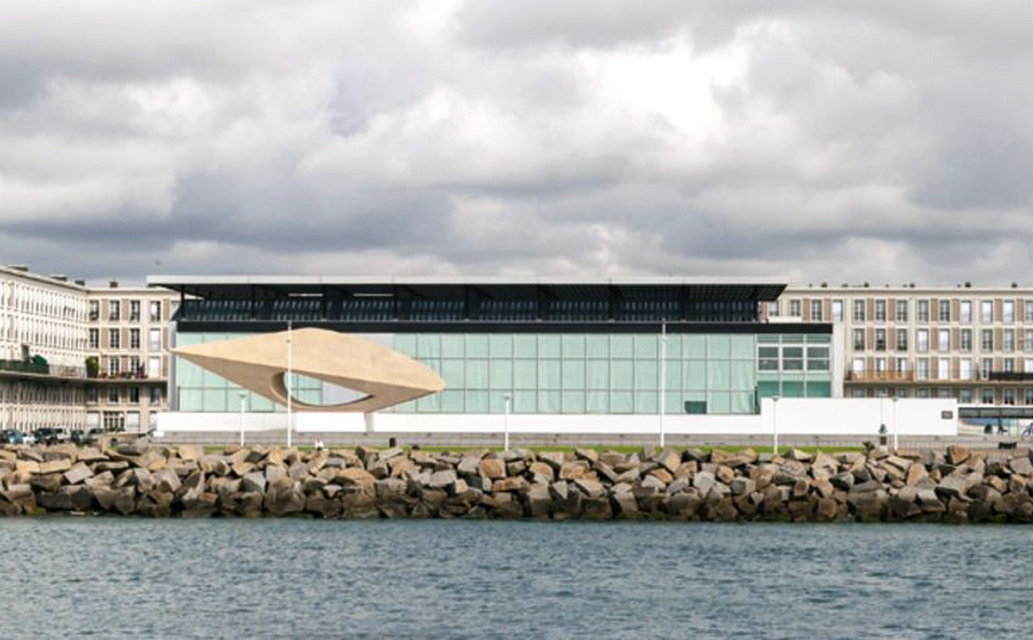The Musée d’art moderne André Malraux is a museum in Le Havre, France containing one of the nation’s most extensive collections of impressionist paintings. It was designed by Atelier LWD, an architecture studio led by Guy Lagneau, Michel Weill and Jean Dimitrijevic. It is named after André Malraux, Minister of Culture when the museum was opened in 1961.
A modern architecture In 1961, under the guidance of Jean Prouvé, students of Auguste Perret; Guy Lagneau, Michel Weil, Jean Dimitrijevic and Raymond Audigier built the Malraux Museum. It is immediately seen as a modern and innovative building. Its glass and steel profile rises like a figure-head over the nearby sea. The Seine Estuary and the light so precious to painters converge to make a scenic background for the fabulous impressionist collection of the Museum. Due to its large glass facade, the visitor attention is naturally and subtly drawn back and forth from the works of art to the landscape and from the landscape to the works of art.
The first impressionist collection of France after Paris. Boudin, Monet, Renoir, Degas, Sisley, Pissarro, Dufy… in their own light. The historic collection comprises works of art of the 16th century to the beginning of the 19th century. Most of the main schools of painting are represented through the works of Simon Vouet, Ribera, Ter Brugghen, Janssens, Dughet, Hubert Robert, etc. It was progressively enriched by the works of art of the 19th century (Courbet, Pissarro, Monet…) and 20th century (Villon, Léger, Dubuffet…). These works are alternately exhibited.
Founded in 1845 and headed by the painter Adolphe-Hippolyte Couveley, the Museum of Fine Arts of Le Havre is completely destroyed by the bombing of the Second World War. The 1,500 paintings evacuated to a safe place are spared, but most of the sculptures left behind disappear. It will be the first museum rebuilt after the war.
As early as 1951, the municipality of Le Havre decided to build a new building. This project begins in 1952, thanks to the combined efforts of Georges Salles, Director of the Museums of France, and Reynold Arnould, a Le Havre artist named Curator of the museums of the city. The two men, who carry out a fundamental reflection on the function of the museum, wish to break with the traditional model, in order to create a constant artistic emulation. The museum must be able to organize conferences, cinematographic projections, concerts, hence the need to multiply spaces, according to new principles of pluridisciplinarity and flexibility, which will inspire in particular the Center Pompidou: exhibition venues, workshops , Reserves, cafeteria, library, discotheque, library … The museum aims to attract the interest of all the public and to contribute to art education, even before it is envisaged to add the function of culture House.
The work, entrusted to Guy Lagneau, dissident architect of the workshop of reconstruction of Auguste Perret, and his associates, Raymond Audigier, Michel Weill and Jean Dimitrijevic begin in 1958. Jean Prouvé collaborates to the construction and realizes in particular the great door Overlooking the sea, the Signal, a monumental sculpture by Henri-Georges Adam, and the museum was inaugurated on June 24, 1961 by André Malraux .
To remedy the deterioration aggravated by the sea air, the municipality decides in 1993 to rehabilitate the museum. The architects Emmanuelle and Laurent Beaudouin, winners of the competition, restructured the building between 1995 and 1999, while upgrading its architectural and landscape qualities. At the end of the works, the museum takes on the name of Malraux Museum, to which will be added the term of modern art in 2011, on the occasion of its fiftieth anniversary.
Indeed, already beneficiary in 1936 of the donation of Charles-Auguste Marande, member of the Cercle of Modern Art of Le Havre, including 89 fawn and impressionist works, 63 paintings, then in 1963 of the legacy by the widow of Raoul Dufy de 70 works by the painter, including 30 paintings, the museum decides to affirm its vocation for this period with a view to a better visibility of its collection, following a new donation of 206 works, including 71 additional paintings.
In 2004, Hélène Senn-Foulds, the granddaughter of the Haitian collector Olivier Senn, also a member of the Cercle de l’Art Moderne, made an exceptional donation to the museum of paintings by masters such as Eugène Delacroix (Paysage in Champrosay) or Gustave Courbet, but above all Impressionists, post-Impressionists and Fauves, with Pierre-Auguste Renoir (Portrait of Nini Lopez), Monet, Henri-Edmond Cross (Vignette Beach), Edgar Degas, Camille Pissarro , Armand Guillaumin, Henri Matisse, Albert Marquet, etc., in addition to the cultural heritage of the municipality.
